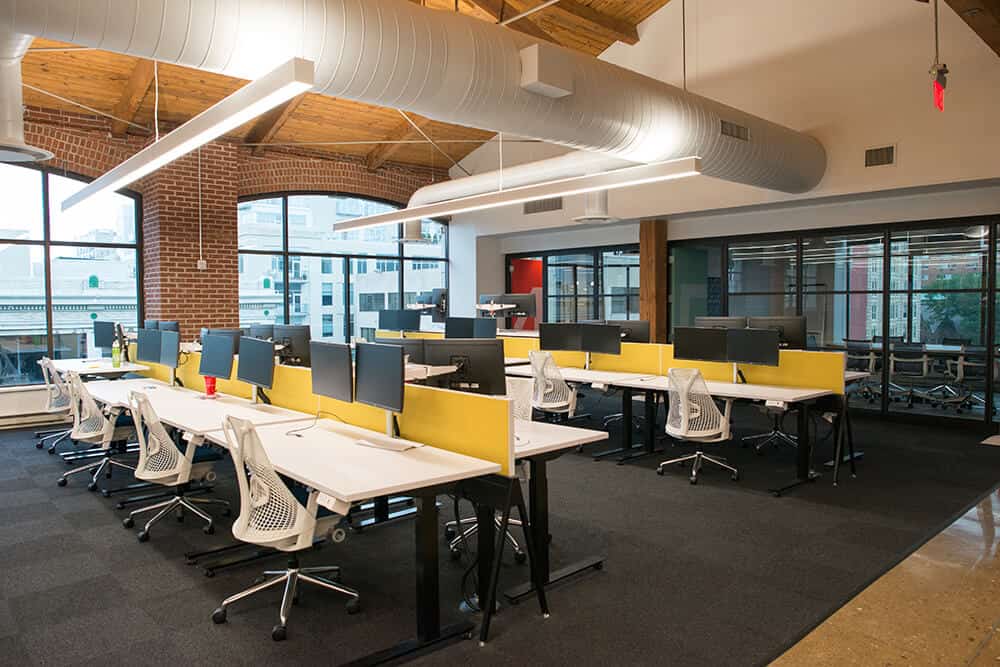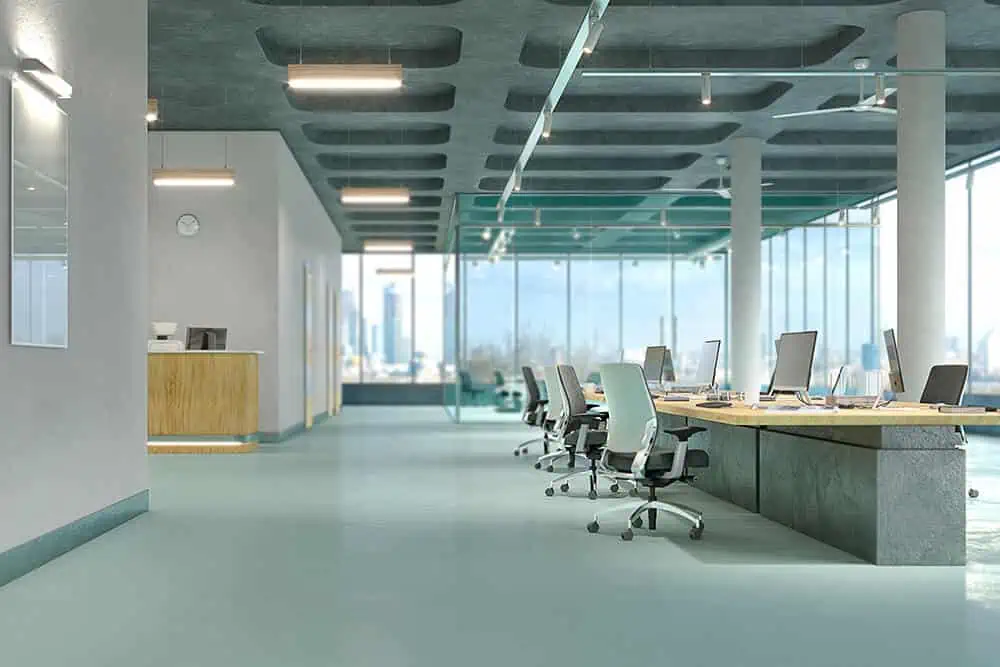You have to invest a lot of money by purchasing the necessary supplies, furniture, etc. to make your office an efficient space. However, office environments always need help to be more productive. You see, the purpose of office lighting is not just to illuminate a specific space. It affects the mood of employees, which is a key factor in improving workplace efficiency. You can't expect employees to improve their performance when they're constantly feeling down.

If you're wondering how important proper lighting is to an office and how to perfect it, you're in the right place. This article will explain everything you need to know about office lighting.
The Importance of Office Lighting
An office is where you want to get work done. Whether you are self-employed or employ others, the purpose of an office is to provide a great working environment. Dim lighting in an office can not only affect the usability of a space, but can also make it feel drowsy. As you will see, lamps have specific characteristics that determine their purpose. We'll cover them in detail later, but for now, you need to know that a problem with any of these features can affect employee performance.
For example, if the light is too dim, it will make workers feel drowsy all the time. Similarly, if the light intensity is too high, it will also cause fatigue due to strain.
Therefore, when designing an office space, it is also important to give as much attention to lighting as to other elements such as interiors and furniture.
Types of Office Lighting
Office lighting can be divided into four broad categories, including:
1. Ambient lighting
Ambient light is the main light source in a space. You can create it using large fixtures with the appropriate color, temperature, intensity and CRI. The purpose of ambient light is to bring utility to a given space. When creating ambient light in your office, make sure it doesn't strain your eyes.
2. Task lighting
As the name suggests, task lights are purpose-built, providing adequate lighting for specific tasks. For example, an office space may have places where employees must read and write documents. Using task lights above these desks can increase productivity in the area.
3. Accent Lighting
Accent lighting highlights specific areas or objects in an office. You can use this on bulletin boards to get the attention of your employees.
4. Decorative lighting
Decorative lighting, as the name suggests, is used to bring life to a place. You can use this lighting to design a workplace that motivates your employees to come. Also, you can use it in areas like the cafeteria to create a different environment from the rest of the office. Doing so will ensure that employees do not feel like they are working during breaks.

Factors to Consider When Choosing Office Lighting
Now that you're familiar with the importance and types of lighting, let's take a look at some of the factors that must be considered along the way.
1. Types of lights
When it comes to lighting your office, you'll find a variety of lighting solutions including halogen bulbs, incandescent bulbs and LEDs. You should always choose LEDs, not only because they are cost-effective, but they are also the most flexible. The market offers all kinds of LEDs in various shapes and sizes, which will help to reproduce the design you have in mind.
For information, you can read
Advantages and disadvantages of LED lighting
Halogen vs. LED Bulbs: How to Choose?
2. Light intensity
Light intensity or brightness is a key factor as it ensures the usability of a place. You should neither be too bright nor too dull. The intensity of light is measured in lumens, and while different spaces have different requirements, for most offices, 40 lumens per square meter is recommended.
For more information you can read Candela vs Lux vs Lumens.
3. Color temperature
Color temperature represents the color emitted by a light fixture across the spectrum. It is measured on the Kelvin scale, which ranges from 1,000 to 10,000K. Lights below 4000K are considered warm because they emit a yellowish tinge. In contrast, lamps over 4000K emit cool white light.
This is a crucial consideration as it determines the mood of employees – lights below 4,000K trigger the body to produce melatonin, the hormone responsible for inducing sleep. As a result, workers feel lethargic all the time. Therefore, when designing office lamps, always choose a temperature equal to or higher than 4,000K.
For information, you can read Optimum color temperatures for LED office lighting.
4. Color rendering index
The color rendering index is another important parameter that indicates how accurately artificial light renders the color of objects compared to natural light. It is measured on a scale of 1 to 100; the closer it is to 100, the better the color the light renders.
That said, you don't always have to render natural colors. A lower CRI may make some parts of the interior look better. You have to keep this concept in mind and use it creatively when designing office lighting.
5. Reduce glare
Exposure to glare can lead to eye strain and long-term medical conditions, making glare reduction important in office spaces. You can't expect employees to deliver while experiencing chronic fatigue. This is even more important when a lot of work has to be done on the screen. You reduce screen glare by optimizing the ambient light around the screen.
As for lamps, there are several anti-glare solutions that can be sourced from the market.
For more information, you can read What is Anti-Glare and How Can I Reduce Glare?
6. energy efficiency
It takes multiple lights to effectively light an office, which means they use up a significant portion of your energy. To reduce overhead, you will have to use energy efficient LEDs. Otherwise, more energy bills will need to be managed individually.

The Benefits of Good Office Lighting
Adequate office lighting will bring several benefits, some of which are as follows:
1. Improve productivity
Proper lighting creates a good working atmosphere and makes employees feel motivated. It increases productivity, which in turn increases overall profits.
2. Reduce eye fatigue
Eye strain is a common problem employees experience in the workplace. Ensuring good lighting can prevent chronic fatigue and keep workers comfortable. Hence, it will increase the productivity and efficiency of employees.
3. Improves mood and well-being
As mentioned earlier, light plays a pivotal role in determining people's mood in any given environment. With plenty of light, employees feel their mood improves, leading to better performance and productivity.
4. Enhanced security
Every workplace has specific hazards that can be minimized with adequate lighting. You can use work lights in accident-prone areas to minimize accidents.

Office Lighting Design Tips
You should now be familiar with the basics of office lighting. While we recommend hiring a professional to light your office, sometimes this is not possible. So if you decide to brighten up your office yourself, the following tips can help:
Determine Lighting Needs
The first thing you must do is determine how much light each area in your office needs. You'll notice that different regions have different requirements. For example, areas where most of the work is done on a laptop or desktop will require higher brightness to reduce glare from the screen. However, it may need revision where people have to read and write on paper.
plan lighting layout
After determining the lighting requirements of different areas, the layout should be designed to meet them. You should know where to mount ambient lights, and where are the best places to mount accent and task lights. When designing the layout, make sure that the beams of the luminaires do not overlap. Also, make sure all areas get the best possible light.
choose lighting
The market offers various types of fixtures with different applications. You should choose those that match your planned layout. The choice of lamps should be based on the area, the height of the suspended ceiling, and the overall layout of the area.
Combine Different Types of Lighting
Using a single type of light can make an area look drab and boring. You can bring life to the place by using different types of lights.
optimize natural light
Optimizing natural light is one of the most important factors in office lighting. With no other options, taking advantage of the full benefits of natural light was crucial. Use natural light as ambient light as much as possible and design the rest of your layout around it. It will improve employee productivity and overall well-being.
Author 2025-06-12
Hishine Group Limited Will Meet Customers In Mexico City.Hishine is thrilled to announce its participation in Expo Eléctrica International 2025, Latin America’s premier trade fair for power and lighti...
Author 2025-05-12
Our recent business trip to Saudi Arabia proved to be a pivotal step in strengthening partnerships and exploring opportunities in the Kingdom’s rapidly growing energy and lighting markets. Below are t...